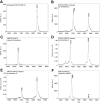Leukocyte proteases cleave von Willebrand factor at or near the ADAMTS13 cleavage site
- PMID: 19541819
- PMCID: PMC2731642
- DOI: 10.1182/blood-2009-01-195461
Leukocyte proteases cleave von Willebrand factor at or near the ADAMTS13 cleavage site
Abstract
The function of von Willebrand factor (VWF) is regulated by proteolysis, which limits its multimeric size and ability to tether platelets. The importance of ADAMTS13 metalloprotease in VWF regulation is demonstrated by the association between severe deficiency of ADAMTS13 and thrombotic thrombocytopenic purpura (TTP). However, ADAMTS13 activity levels do not always correlate with the clinical course of TTP, suggesting that other proteases could be important in regulating VWF. We identified 4 leukocyte proteases that cleave the synthetic VWF substrate FRETS-VWF73 and multimeric VWF. Elastase and proteinase 3 (PR3) cleave multimeric VWF and FRETS-VWF73 at the V(1607)-T(1608) peptide bond; cathepsin G and matrix metalloprotease 9 cleave VWF substrates at the Y(1605)-M(1606) and M(1606)-V(1607) bonds, respectively. Isolated intact human neutrophils cleave FRETS-VWF73 at the V(1607)-T(1608) peptide bond, suggesting that elastase or PR3 expressed on leukocyte surfaces might cleave VWF. In the presence of normal or ADAMTS13-deficient plasma, cleavage of FRETS-VWF73 by resting neutrophils is abolished. However, activated neutrophils retain proteolytic activity toward FRETS-VWF73 in the presence of plasma. Although the in vivo relevance remains to be established, these studies suggest the existence of a "hot spot" of VWF proteolysis in the VWF A2 domain, and support the possibility that activated leukocytes may participate in the proteolytic regulation of VWF.
Figures



 indicates the cleavage products of various sizes under denaturing and reducing conditions.
indicates the cleavage products of various sizes under denaturing and reducing conditions.
 (right borders) indicates positions of cleavage products. The asterisk in panel C denotes 20 mM EDTA added to the reaction mixture.
(right borders) indicates positions of cleavage products. The asterisk in panel C denotes 20 mM EDTA added to the reaction mixture.


Similar articles
-
Neutrophil Protease Cleavage of Von Willebrand Factor in Glomeruli - An Anti-thrombotic Mechanism in the Kidney.EBioMedicine. 2017 Feb;16:302-311. doi: 10.1016/j.ebiom.2017.01.032. Epub 2017 Jan 24. EBioMedicine. 2017. PMID: 28139439 Free PMC article.
-
FRETS-VWF73 rather than CBA assay reflects ADAMTS13 proteolytic activity in acquired thrombotic thrombocytopenic purpura patients.Thromb Haemost. 2014 Aug;112(2):297-303. doi: 10.1160/TH13-08-0688. Epub 2014 Apr 17. Thromb Haemost. 2014. PMID: 24740645
-
Zinc and calcium ions cooperatively modulate ADAMTS13 activity.J Biol Chem. 2006 Jan 13;281(2):850-7. doi: 10.1074/jbc.M504540200. Epub 2005 Nov 11. J Biol Chem. 2006. PMID: 16286459
-
Thrombotic thrombocytopenic purpura: basic pathophysiology and therapeutic strategies.Hematology Am Soc Hematol Educ Program. 2013;2013:292-9. doi: 10.1182/asheducation-2013.1.292. Hematology Am Soc Hematol Educ Program. 2013. PMID: 24319194 Review.
-
[Development and application of a new ADAMTS13 assay for TTP diagnosis].Rinsho Byori. 2005 Jul;53(7):639-45. Rinsho Byori. 2005. PMID: 16104533 Review. Japanese.
Cited by
-
Gain-of-function ADAMTS13 variants that are resistant to autoantibodies against ADAMTS13 in patients with acquired thrombotic thrombocytopenic purpura.Blood. 2012 Apr 19;119(16):3836-43. doi: 10.1182/blood-2011-12-399501. Epub 2012 Jan 30. Blood. 2012. PMID: 22289888 Free PMC article.
-
Apolipoprotein B100/Low-Density Lipoprotein Regulates Proteolysis and Functions of von Willebrand Factor under Arterial Shear.Thromb Haemost. 2019 Dec;119(12):1933-1946. doi: 10.1055/s-0039-1696713. Epub 2019 Sep 7. Thromb Haemost. 2019. PMID: 31493779 Free PMC article.
-
Neutrophil Protease Cleavage of Von Willebrand Factor in Glomeruli - An Anti-thrombotic Mechanism in the Kidney.EBioMedicine. 2017 Feb;16:302-311. doi: 10.1016/j.ebiom.2017.01.032. Epub 2017 Jan 24. EBioMedicine. 2017. PMID: 28139439 Free PMC article.
-
Essential domains of a disintegrin and metalloprotease with thrombospondin type 1 repeats-13 metalloprotease required for modulation of arterial thrombosis.Arterioscler Thromb Vasc Biol. 2011 Oct;31(10):2261-9. doi: 10.1161/ATVBAHA.111.229609. Epub 2011 Jul 28. Arterioscler Thromb Vasc Biol. 2011. PMID: 21799176 Free PMC article.
-
Phenotypic expression of ADAMTS13 in glomerular endothelial cells.PLoS One. 2011;6(6):e21587. doi: 10.1371/journal.pone.0021587. Epub 2011 Jun 24. PLoS One. 2011. PMID: 21720563 Free PMC article.
References
-
- Furlan M, Robles R, Galbusera M, et al. Von Willbrand factor-cleaving protease in thrombotic thrombocytopenic purpura and the hemolytic uremic syndrome. N Engl J Med. 1998;339(22):1578–1584. - PubMed
-
- Desch KC, Motto DG. Thrombotic Thrombocytopenic Purpura in Humans and Mice. Arterioscler Thromb Vasc Biol. 2007;27(9):1901–1908. - PubMed
Publication types
MeSH terms
Substances
Grants and funding
LinkOut - more resources
Full Text Sources
Other Literature Sources
Molecular Biology Databases
Miscellaneous

